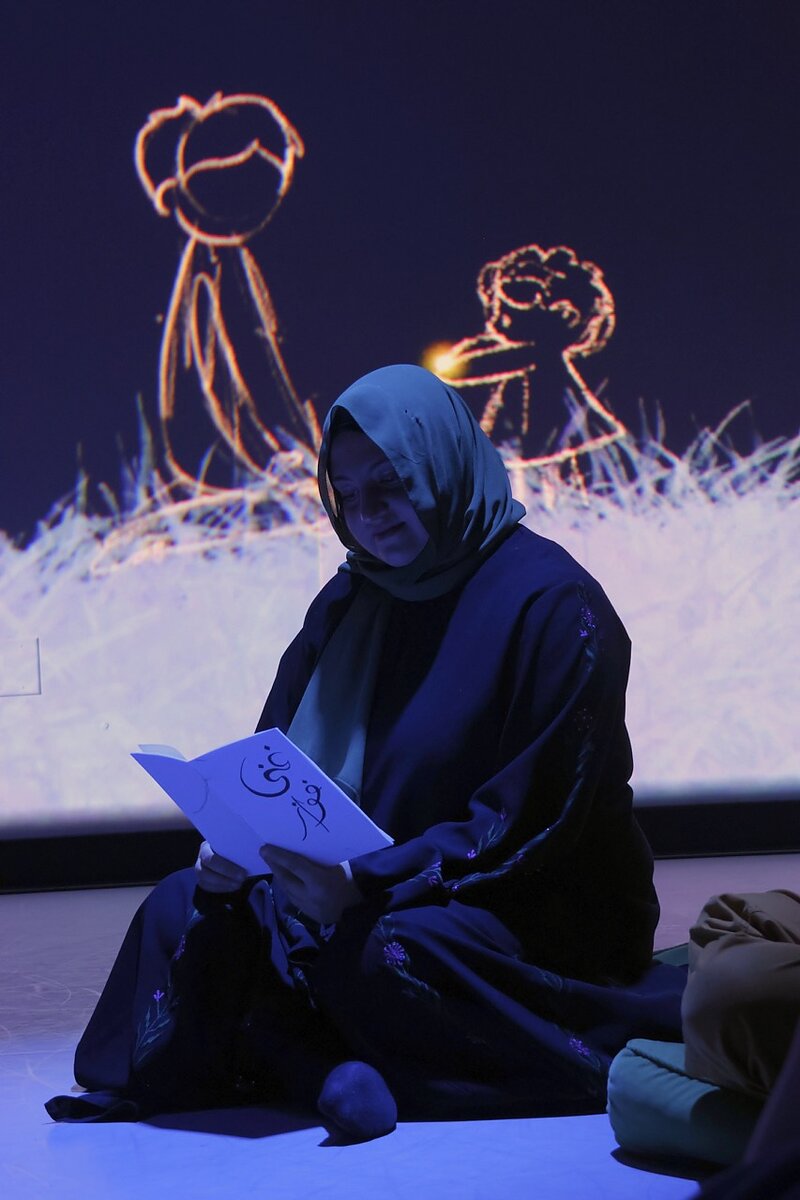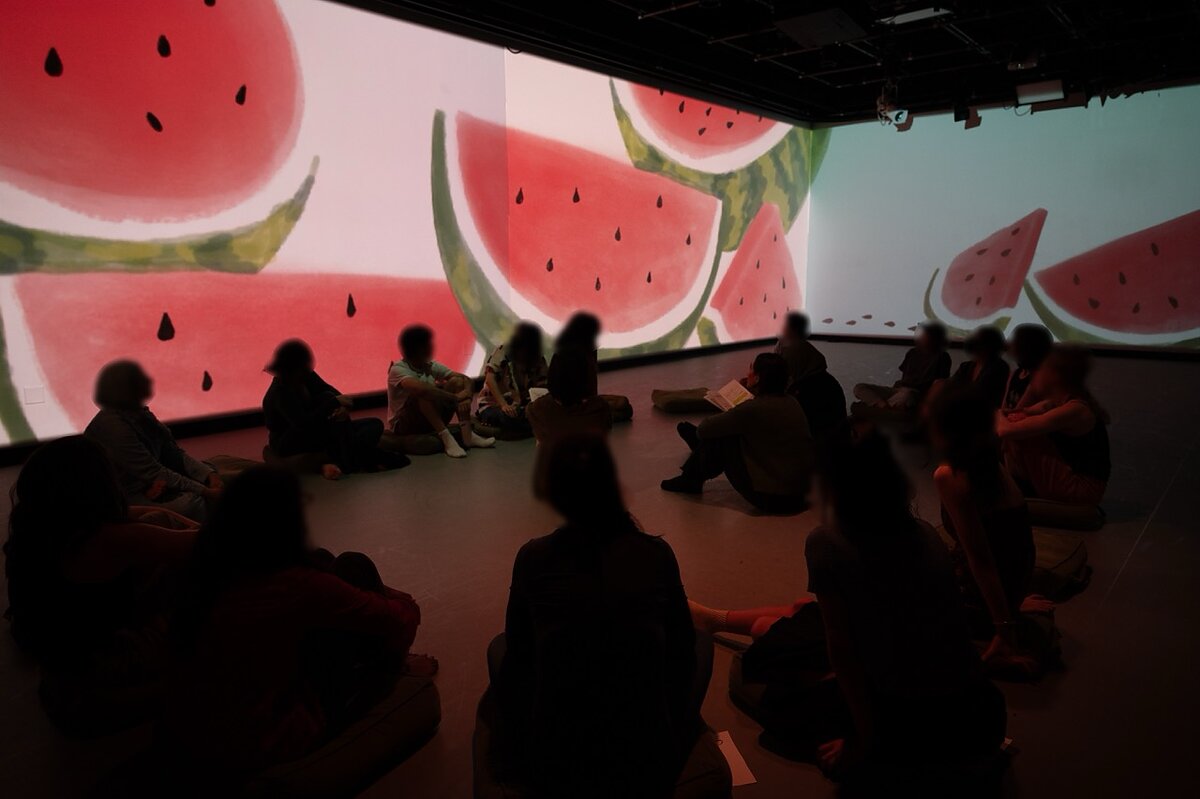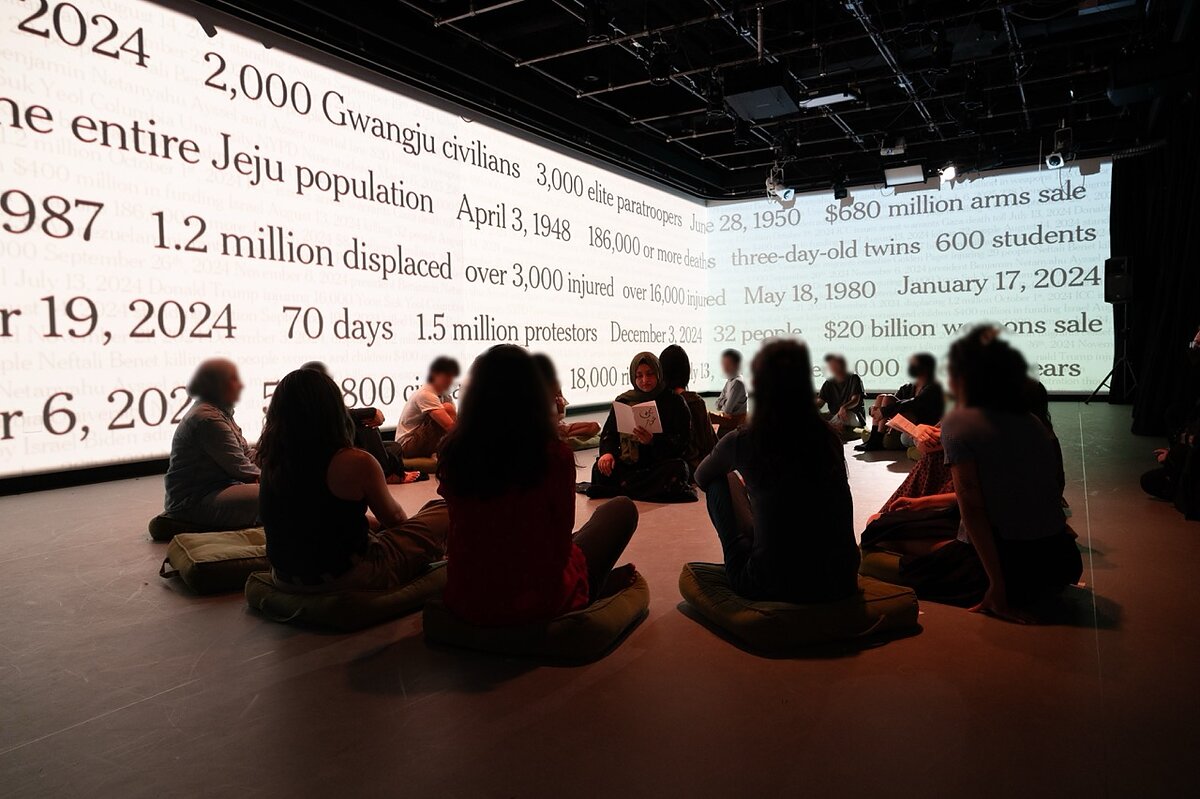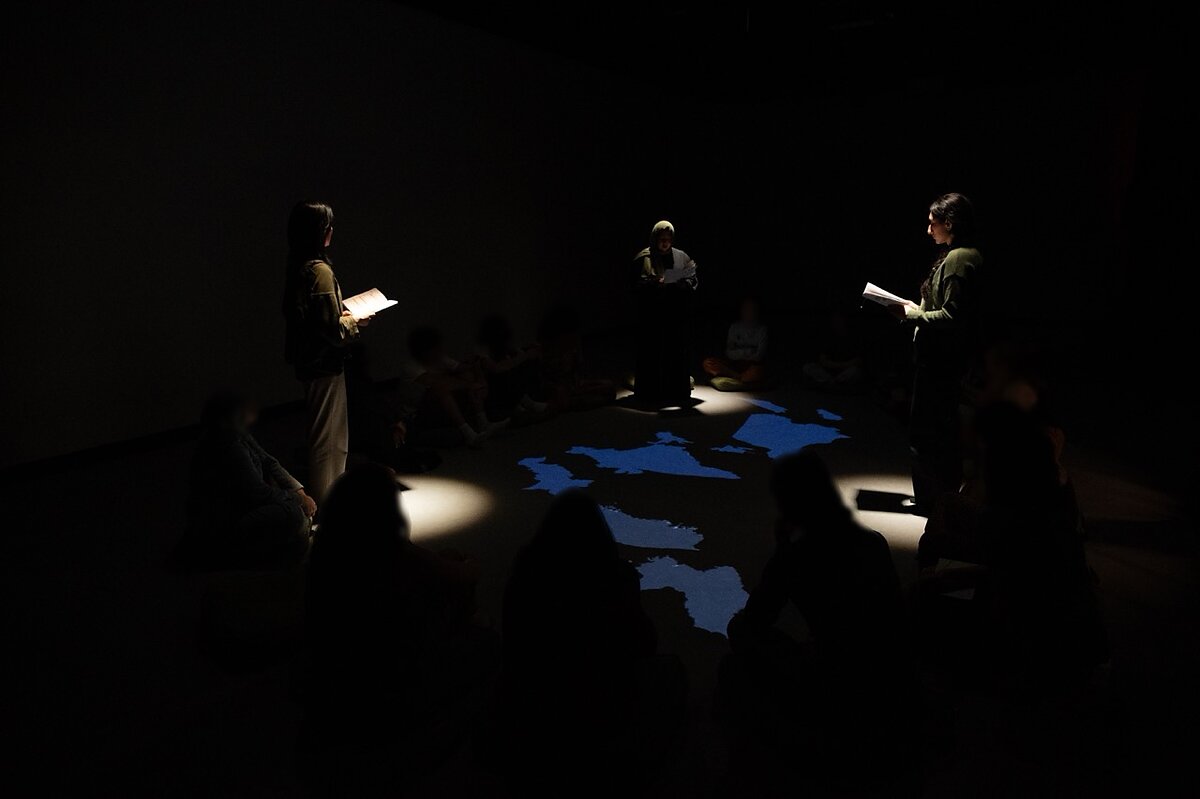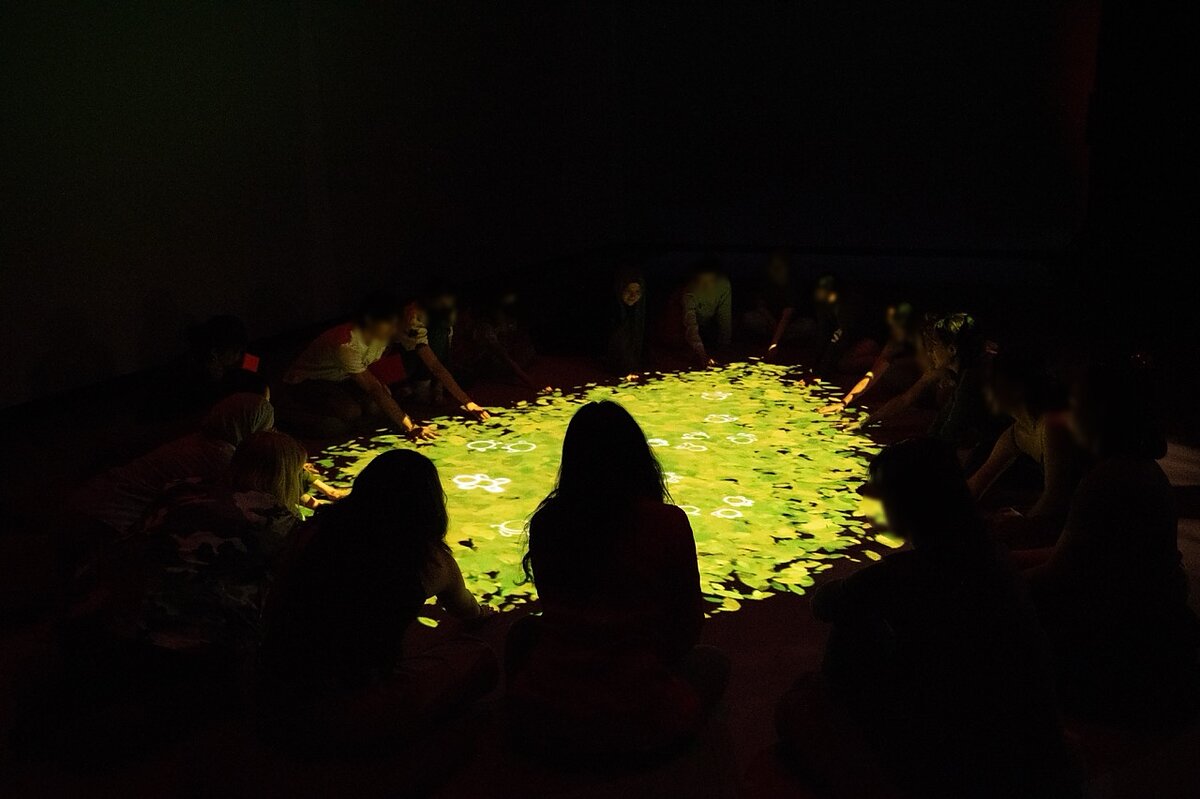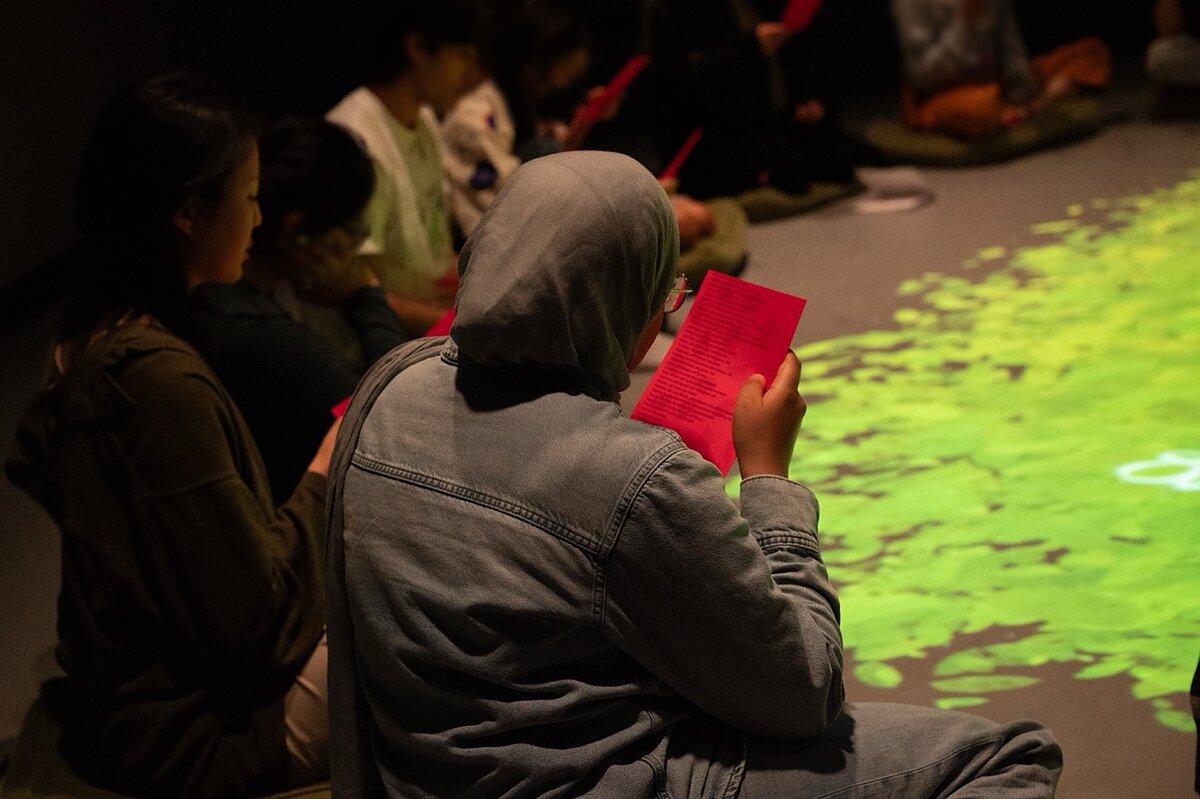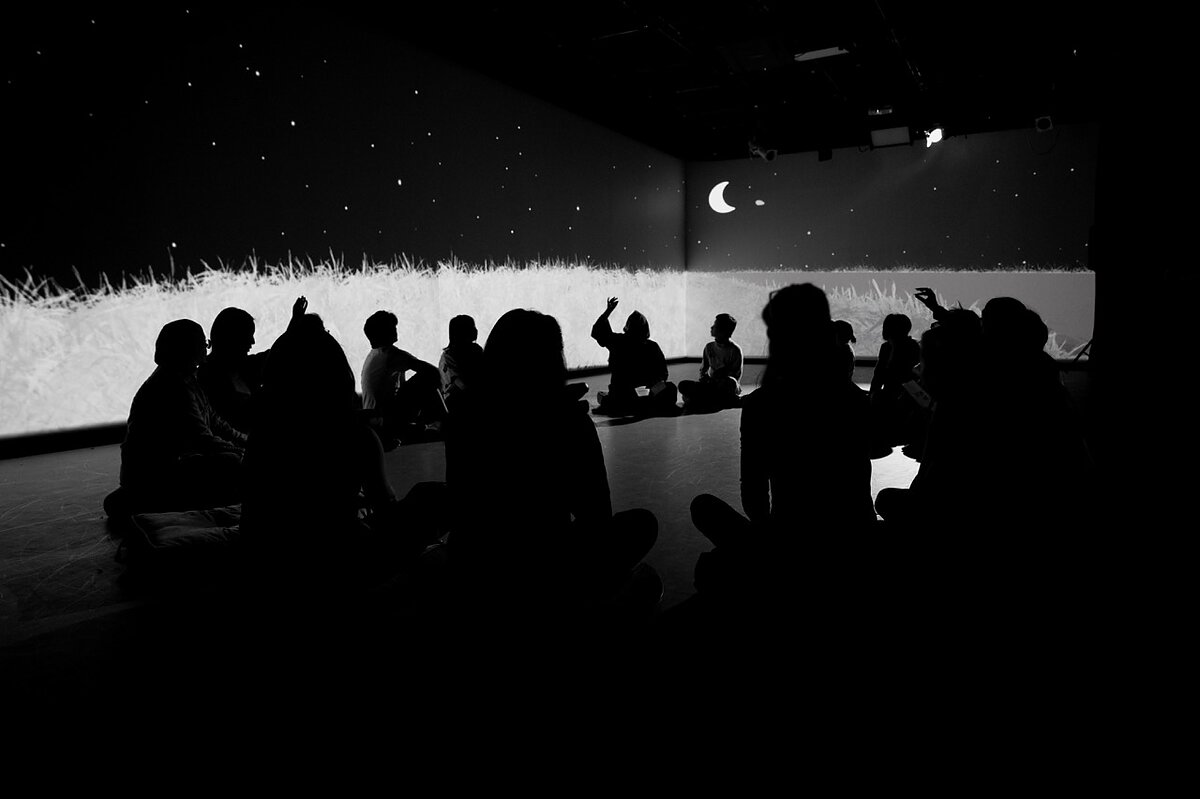Playwright Ghina Fawaz on Processing History from Within
One weekend this past April, I was invited to attend a work-in-progress showing of a play called Watermelon Boy at Barnard College, the affiliate women’s college of Columbia University. Part fairy tale, part documentary, the immersive multimedia production roots itself in the common myth of a watermelon growing in one’s belly upon eating its seed—from it emerges a potent metaphor for Palestinian resistance and anti-colonial solidarity.
Co-devised by Ghina Fawaz, Chaesong Kim, and Anuka Sethi, the play begins with the story of a young Palestinian boy living under Israeli occupation who eats a watermelon seed and is turned into a watermelon when IDF soldiers raid his family’s home. The boy is thus transformed into a symbol.
From this act, tendrils spread across continents and time to reflect on moments in history and our present that have asked that we, in our own ways, become watermelons. Reflecting on their respective backgrounds as Arab, Korean, and Indian artists, Fawaz, Kim, and Sethi call on shared legacies of colonialism and oppression: footage from the Gaza solidarity encampments is shown alongside the 1980 student uprising in Gwangju, Korea.
Watermelon Boy takes its site within Barnard as a critical point of perspective. The university continues its relentless crackdown on pro-Palestinian activism and speech, complying with Trump administration orders to send Immigration and Customs Enforcement agents to arrest, detain, and threaten to deport student activists like Mohsen Mahdawi and Mahmoud Khalil. Interspersed within these fictional and historical narratives are news headlines, updated to the moment of the show.
Sitting alongside about a dozen audience members arranged in a circle on the floor, Fawaz, Kim, and Sethi narrated through events fictional, historical, and current in a potent three-part montage that captures the whirling tempest of our current moment from its eye. At its conclusion, the play invites audience members to eat a watermelon seed that is offered to them and consider our communion.
A few days after attending Watermelon Boy, I spoke with Fawaz over Zoom to discuss how the play came to be. In our conversation, we spoke about the slipperiness of capturing history in real time, the influence of David Henry Hwang, and how art is a powerful force for resistance.
This interview has edited for length and clarity.
GF: Every day there’s something new. I try to write everything down immediately. I’ll pull out my notebook as something is happening and write down what I’m feeling, especially because these events that are happening to me and around me feel so poetic. I need to capture them as they’re happening.
For example, during the Q&A of yesterday’s screening of The Encampments, one of the speakers revealed that, as we were watching the film, Mahmoud Khalil’s wife was giving birth to their first child while Mahmoud was still in ICE detention. I wrote that down with the date, April 21, 2025, and thought, how do I process this and use it to fuel my future fight for liberation?
I also process through illustrating and talking with my family and collaborators.
GF: I am a student artist in residence at the Barnard Movement Lab, but this play came about a year ago, before I got this residency. It started from this very small idea. I was at home for break and had this idea about a boy who eats a watermelon seed. There’s that classic thing that parents tell children—that if you eat a watermelon seed, a watermelon will grow in your stomach.
I thought that was quite beautiful. Watermelons are a symbol of Palestinian resistance since they are the same colors as the Palestinian flag, which is banned. I went on many walks with my mother where we talked about what might happen when the boy eats the seed. Does a little nation grow in his stomach? What if he becomes a watermelon and that is his resistance? What does it mean for a child to become a symbol of liberation? I thought about the children of Gaza who have become watermelon boys and girls. I wanted to write something that held them up in a way that honored their childhood and spoke to the sacrifices they were forced to make.
I’m from the south of Lebanon. My family is directly impacted by our border and Israel’s current invasion. At the time of my first thinking about this play, however, the official invasion hadn’t started and so my full focus was on the children of Palestine.
And so I wrote this 10-page play about this watermelon boy where, at the end of the story, the boy becomes a watermelon. There’s a night raid that happens and the soldiers discover that the family is harboring a watermelon which is forbidden. There are many things that are banned for Palestinians in occupied territories. They cannot collect rainwater, for example.
By adding this sort of fairy tale narrative, I hoped that it would allow more people to understand and relate to this reality and reflect on their own cultures and experiences with colonialism. I submitted the play to a festival where it wasn’t accepted. My friend Chaesong, however, was one of the directors on the festival’s panel. She reached out a few months later and told me she couldn’t stop thinking about Watermelon Boy and that she’d love to direct it!
In talking to Chaesong, who is from Korea, we discovered how there are so many similarities in how colonialism has impacted our lives. Because Chaesong has an incredible background in documentary theater, we began to think about the possibility of incorporating documentary into this fairy tale.
I came in asking what it means to become a symbol of resistance. Chaesong came in asking how we write history as it’s unfolding.
GF: Yes! In my conversations with Chaesong, we started asking ourselves if there were more watermelon children around the world, across the globe—and whether we could also become watermelon boys.
We started approaching the documentary portion of the play about a year ago. I was at the Gaza Solidarity Encampment at Columbia. I wasn’t sure how to capture everything. When Israel invaded Lebanon, thousands of people were killed, including members of my own family. I was working on my thesis at the time on The Thousand and One Nights and I felt the responsibility to use my privilege as a student at Columbia University to amplify the stories and names of the thousands upon thousands who have been violently erased and silenced.
We submitted the play to a few different places but were thrilled when we got accepted into the Movement Lab. It’s a spectacular space for creation and exploration, with its laboratory ethos. It has all of this incredible technology we get to play and create with. This is where Anuka came in as our producer.
Anuka is from India, and so between the three of us (myself being from Lebanon and Chaesong from Korea), we started to have these conversations about lines and borders. It was remarkable to see how similar we are as we shared the histories of our nations. How many other places in the world share these experiences, including the very land we’re standing on?
SL: I thought the fairy tale of the watermelon children was such a beautiful vessel for solidarities. I also loved integrating the personal political lineages of you, Anuka, and Chaesong—how each of you came to embody these legacies of colonialism. Through that, you were able to grow these vining tendrils out and invite the possibility for watermelon children within the audience.
I’m curious to see how you see this play developing beyond Movement Lab, especially given how site and time specific its current iteration is.
GF: We are very excited to continue developing Watermelon Boy and start the process of expanding it. This play will feel different every day. Even now, we’re adding information about Kilmar Abrego Garcia. We’re going to add more documentary sections and more watermelon boys. It is intimidating to think about what could happen in a year from now.
We might have more collaborators, more stories, more borders to rewrite and redraw. The ending of the show will remain the same, including the top headline the day of that performance and the transformation of audience members into watermelon boys.
GF: The original idea I had was more of an illustrated story. The deadline for the festival was what made me turn it into a play. Then when I met with Chesong, the possibilities expanded. Do we add puppets? Projection? Film? Live action? Documentary? When we got accepted into the Movement Lab, it actually answered the question because it’s so interdisciplinary. We could blend all these things for it to be what it needed to be.
Our lighting designer, Ari, our production designer, Etzu, and our stage management team, Fuyuan and Zoe, were all fantastic. They all further expanded our vision by bringing their expertise. It allowed us to use projections and have audiences interact with them.
SL: There’s that one scene where the audience touches the ground and a boy emerges from the projection and we’re invited to wave to him before a lily pad emerges and we’re invited to push it across the stage. I thought the mediums through which you presented this play were really effective in inviting the audience to become an active participant within this story of resistance.
During the play, David Henry Hwang is mentioned. He is also incredibly versed in experimenting with personal narrative and creating out of personal and political histories.
GF: David is such an incredible person! I read his play Yellow Face at the encampment and as helicopters and drones flew in the sky above us, I felt the pages blur into the moments I was living in. I knew I needed to be part of the play’s journey on Broadway and asked David if I could assist him; he said I could!
That was one of the best experiences I had at Columbia. I was surrounded by the most incredible artists like Leigh Silverman and Daniel Dae Kim working on this brilliant, funny, and groundbreaking piece. It really impacted the way that I approached Watermelon Boy. I asked him so many questions like what to do when you’re writing a documentary about the current moment. He told me to record myself all the time, all the conversations I’m having.
GF: The future feels a little bit foggy right now. It feels a little bit hopeless. It feels really difficult. One thing I do know is that no matter what happens, we can take it and use it to resist in whatever way we can. We have this incredible opportunity, this privilege, and this gift of sorts to tell stories, to be artists. Part of our liberation is through our artistic contributions. When you look back in history, it’s the art that people remember and look at to understand what people were saying and feeling at the time.
I had conversations with David about this as well because over the course of Yellow Face is when Trump was elected. Daniel Dae Kim had mentioned that the show after the election was profound because it was this shared community experiencing this united desire for liberation. And so now we’re here, in four months into this administration. Who knows what it will be like in year three, year 15? All I know is that it’s an empowering thing to think about art being our weapon.
